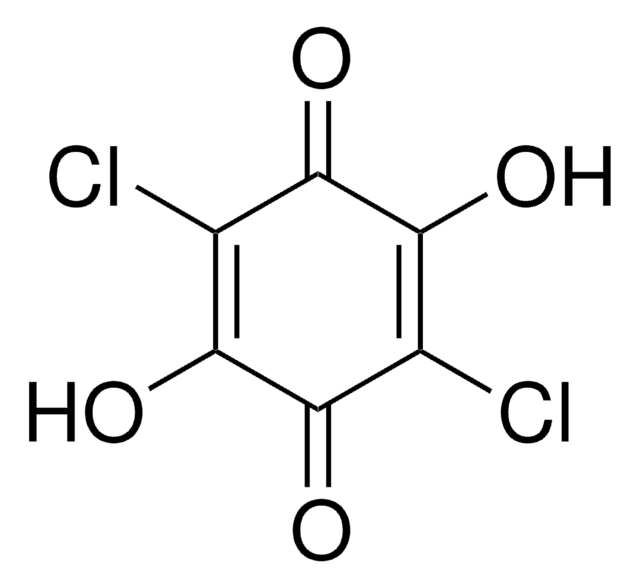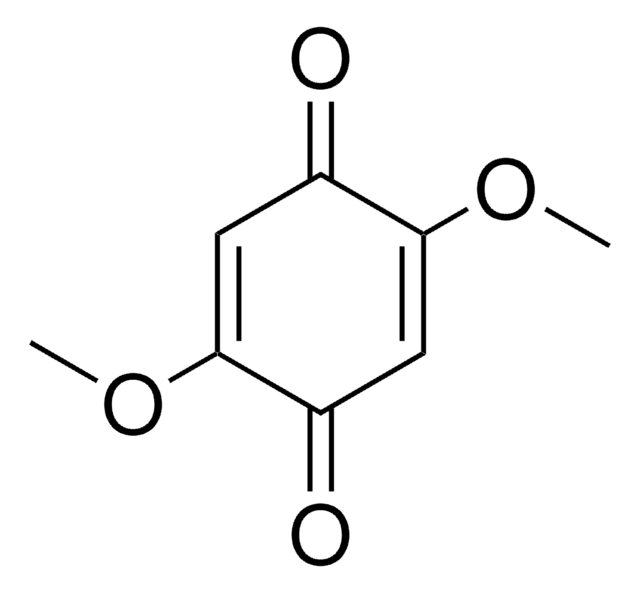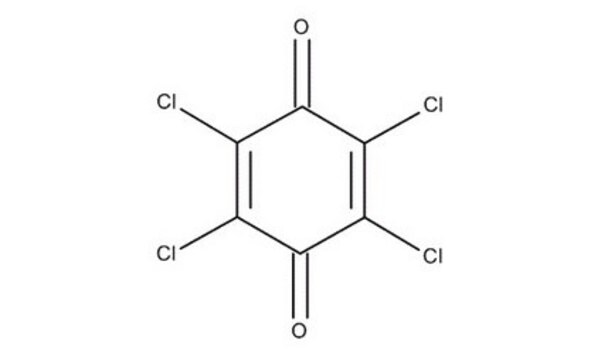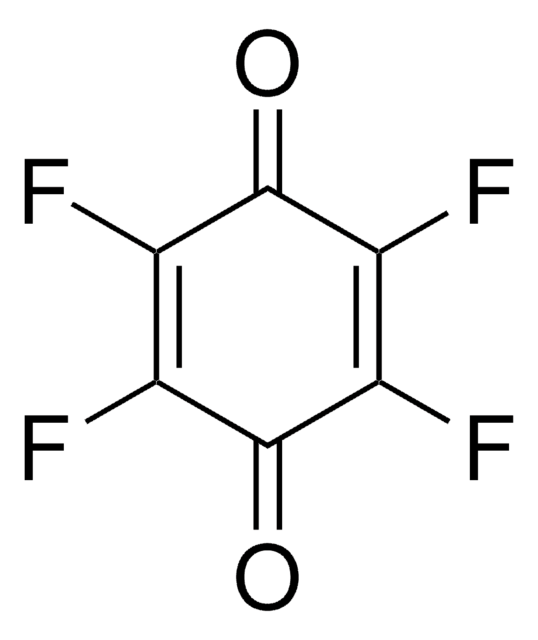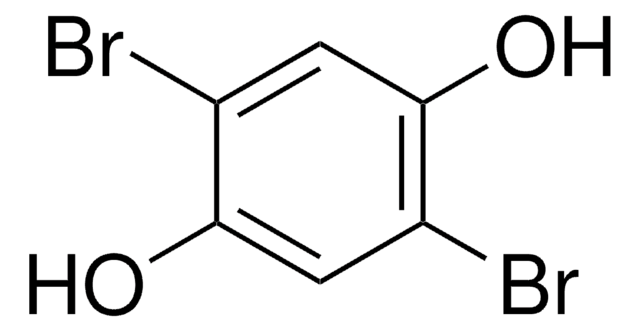431974
2,5-Dichloro-1,4-benzoquinone
98%
Sinónimos:
2,5-Dichloro-2,5-cyclohexadiene-1,4-dione, 2,5-Dichloro-p-benzoquinone
Iniciar sesiónpara Ver la Fijación de precios por contrato y de la organización
About This Item
Fórmula empírica (notación de Hill):
C6H2Cl2O2
Número de CAS:
Peso molecular:
176.98
Número CE:
Número MDL:
Código UNSPSC:
12352100
ID de la sustancia en PubChem:
NACRES:
NA.22
Productos recomendados
Nivel de calidad
Análisis
98%
mp
160-163 °C (lit.)
grupo funcional
chloro
ketone
cadena SMILES
ClC1=CC(=O)C(Cl)=CC1=O
InChI
1S/C6H2Cl2O2/c7-3-1-5(9)4(8)2-6(3)10/h1-2H
Clave InChI
LNXVNZRYYHFMEY-UHFFFAOYSA-N
Descripción general
2,5-Dichloro-1,4-benzoquinone (DCBQ) is a halogenated quinone. DCBQs are carcinogenic intermediates.They have benn identified as chlorination disinfection byproducts in drinking water. DCBQ has been reported to increse the decomposition of a model ROOH tert-butylhydroperoxide, via formation of t-butoxyl radicals. The isomers of the DCBQ dimer have been investigated for the non-covalent interactions (NCIs) by quantum chemical calculations. Halogen bond present in 2,5-dichloro-1,4-benzoquinone have been investigated by experimental as well as theoretical charge density analysis. Its reaction with pyrrolidine has been investigated.
Aplicación
2,5-Dichloro-1,4-benzoquinone may be used in the following processes:
- As a starting material in the synthesis of asterriquinone D.
- As a model to study the utility of a novel photoreactor with LED (light-emitting diode) light source and a fibre-optic CCD (charge-coupled device) spectrophotometer.
- 2,5-dichloro-3,6-bi(3-indolyl)-1,4-hydroquinone synthesis by palladium catalyzed reaction with indole.
Palabra de señalización
Warning
Frases de peligro
Consejos de prudencia
Clasificaciones de peligro
Eye Irrit. 2 - Skin Irrit. 2 - STOT SE 3
Órganos de actuación
Respiratory system
Código de clase de almacenamiento
11 - Combustible Solids
Clase de riesgo para el agua (WGK)
WGK 3
Punto de inflamabilidad (°F)
Not applicable
Punto de inflamabilidad (°C)
Not applicable
Equipo de protección personal
dust mask type N95 (US), Eyeshields, Gloves
Elija entre una de las versiones más recientes:
¿Ya tiene este producto?
Encuentre la documentación para los productos que ha comprado recientemente en la Biblioteca de documentos.
Los clientes también vieron
B Vijaya Pandiyan et al.
Physical chemistry chemical physics : PCCP, 16(37), 19928-19940 (2014-08-15)
The competition between non-covalent interactions (NCIs), such as C-H∙∙∙O, C-H∙∙∙Cl, C-Cl∙∙∙O, C-Cl∙∙∙Cl-C, C-O∙∙∙C, C-Cl∙∙∙C and C-O∙∙∙π, in the isomers of the 2,5-dichloro-1,4-benzoquinone (DCBQ) dimer were investigated by quantum chemical calculations to study the properties of the ground and excited states.
Halogen bonding in 2, 5-Dichloro-1, 4-benzoquinone: Insights from experimental and theoretical charge density analysis.
Hathwar VR, et al.
Crystal Growth & Design, 11(5), 1855-1862 (2011)
Chun-Hua Huang et al.
Chemical research in toxicology, 28(5), 831-837 (2015-03-20)
Halogenated quinones (XQ) are a class of carcinogenic intermediates and newly identified chlorination disinfection byproducts in drinking water. Organic hydroperoxides (ROOH) can be produced both by free radical reactions and enzymatic oxidation of polyunsaturated fatty acids. ROOH have been shown
Virág Kiss et al.
Photochemical & photobiological sciences : Official journal of the European Photochemistry Association and the European Society for Photobiology, 16(4), 519-526 (2016-12-13)
Substituted 1,4-benzoquinone (QR) derivatives are photosensitive in aqueous solution and form hydroquinones (QR-H
Construction of a photochemical reactor combining a CCD spectrophotometer and a LED radiation source.
Gombar M, et al.
Photochemical & Photobiological Sciences : Official Journal of the European Photochemistry Association and the European Society for Photobiology, 11(10), 1592-1595 (2012)
Nuestro equipo de científicos tiene experiencia en todas las áreas de investigación: Ciencias de la vida, Ciencia de los materiales, Síntesis química, Cromatografía, Analítica y muchas otras.
Póngase en contacto con el Servicio técnico


